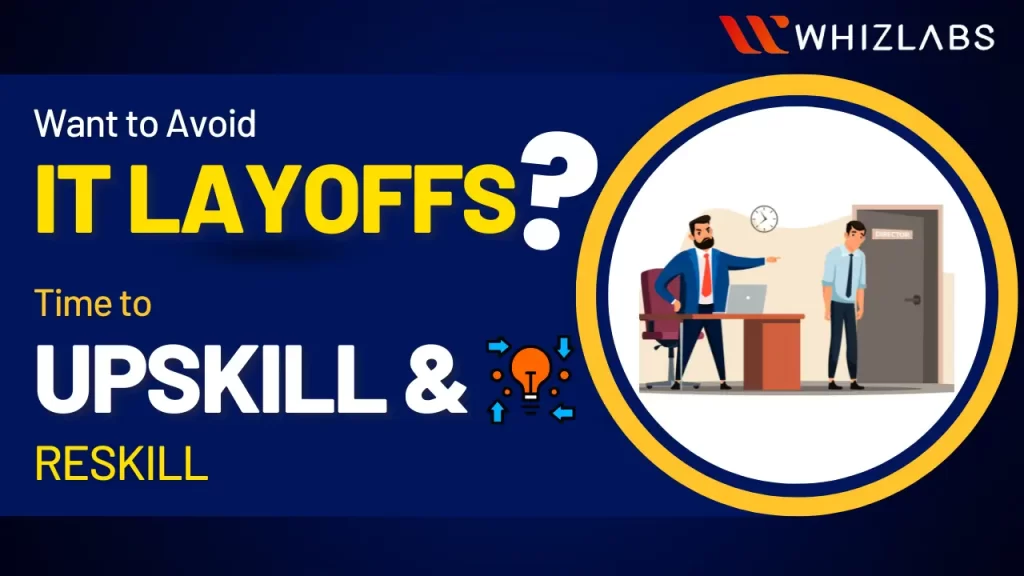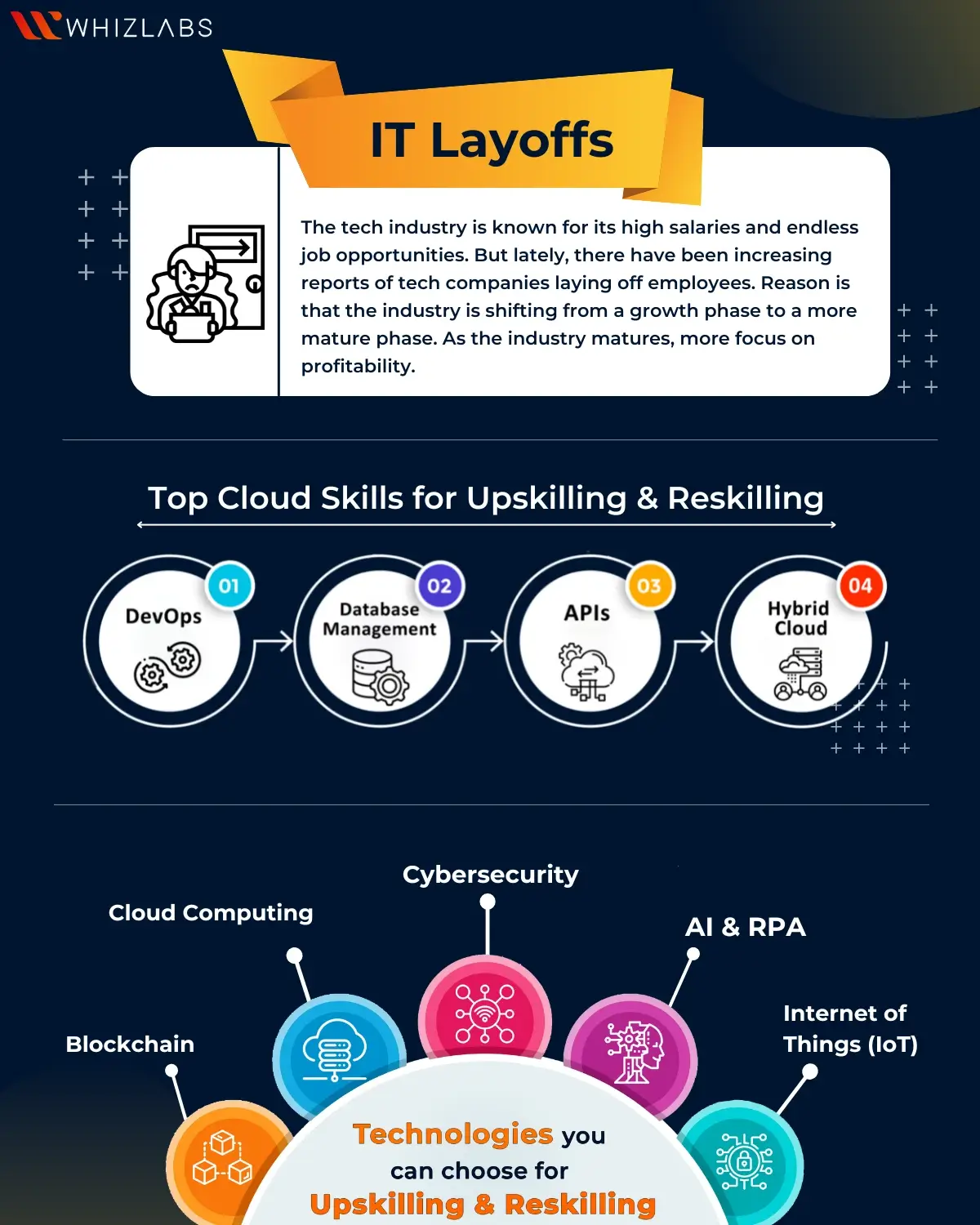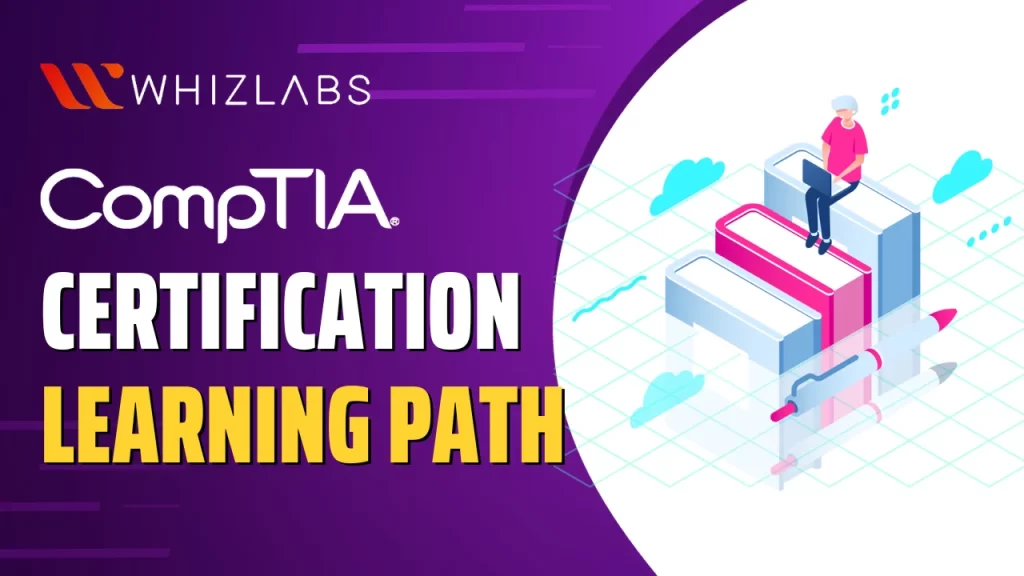Layoffs and quiet quitting in tech are for real this year. You must have read or heard in 2022 where big-shot names like Meta laid off 11,000 workers, Amazon fired 10,000 staff, and so on. As per NDTV report after Amazon And Microsoft, Cisco to Lay Off 4,000 Employees in December 2022.
According to Mint, around 849 IT firms have gotten rid of nearly 136,000 people by November 2022. A scary picture isn’t it?
To save yourself from this wrath, you must continuously upskill and reskill. These two terms are beyond buzzwords. It’s the only way to stand out from the crowd and emerge as an asset to your organization. This blog talks about why you should upskill and reskill, why your organization expects you to consider it, and how you can start the journey.
But before that, let’s first take a dive into the ‘IT layoffs 2022’ scenario.
The Layoffs in Tech 2022 Story
The layoffs in tech 2022 are getting bigger and bigger. Here are a few figures to consider:
- In November, US tech firms let go of more than 45000 employees at one go. Sadly, 25000 employees out of this belonged to big names like Meta and Twitter.
- Reports suggest Google could lay off 10000 workers by early 2023.
- So far in 2022, around 85000 professionals have lost their jobs.
The numbers are getting bigger and bigger with each passing day. Numerous reasons are responsible for mammoth firing.
Why do you need to upskill and reskill?
For one reason, the IT landscape changes in the blink of an eye. Whenever a new transformation begins to drive the industry, the first tendency of any company is to hire someone NEW so they can build new business processes. But imagine if you upskill yourself in the same domain, you will not only elevate your career but also help your company align their business models with the change.
Apart from this, here are a few more reasons why you need to upskill and reskill:
The changing organizational culture
Our daily chores and jobs are becoming different in nature. Most firms now include digital transformation in their long-term strategic plans. Since robots or software are performing many regular tasks, AI, automation and AR have led to massive disruptions in employment scenarios.
As a result, the industry is creating new roles that require various skills. Unlike when companies had to depend only on domain-specific tech experts, professionals from all fields are learning to use numerous cloud-based tools and platforms.
Do you remember the last time you had to request IT? Now that those times are over, everyone must possess greater digital skills.
Evolving workforce
Workforces across organizations are undergoing countless structural changes as senior workers retire. Younger generations that have grown up in a society marked by rapid technological change are aware of how important staying current is for career advancement.
Together with the most recent generation, iGen (born 1995–2012), GenZ is the generation that is just beginning to enter the workforce after graduating. When taking a job, both strongly emphasize ongoing education.
All professionals, regardless of age, are fully aware of the importance of regularly upgrading and retraining to advance their professions.
Increase employee engagement
In younger generations, psychological safety, acceptance, and feeling appreciated are highly valued. A reskilling and upskilling culture at work fosters increased employee loyalty, enhanced motivation, and an improved work environment.
Streamline future career goals and personal branding
There are several advantages to filling skill gaps in companies, especially those pertaining to succession planning, as they can form diversified teams. Instead of bringing in outside personnel, it may be more affordable and efficient to teach current employees.
If you want to be a part of this candidate-driven market and survive the grand layoff, you need to upskill and reskill and prove that you can be as efficient as the new hire.
Even organizations expect you to upskill and reskill
In a recent report by PwC, 79% of CEOs have expressed deep concerns regarding whether their existing workforce is capable enough to meet the ever-evolving tech challenges. Another study from Deloitte shows similar patterns. In the coming three years, over 50% of employees across the industry need to upskill and reskill, not just in tech but also in soft skills.
Interestingly, these massive IT layoffs are a lose-lose situation for both firms and professionals. While professionals have a hard time searching for new employment, companies have to undergo countless onboarding and additional hiring costs. Both organizations and employees have to act proactively and save the layoff hazard.
How can tech employees start their upskilling and reskilling journey?
Going for official training
Here are a few options for official training:
- Sponsored education at colleges or universities like corporate financial assistance, day releases to attend classes and actively study in order to prepare for tests or certification.
- Lunch and learn events held on-site or online where professionals present workshops in their specialized fields. These are especially helpful for workers who find it difficult to attend evening classes or even to quit their day jobs.
Contribute to open source
This is the best way to self-train yourself. As the name suggests, open-source projects allow everyone access to resources, collaborate with experts and skilled professionals, and bond with the community. The icing on the cake, you might find someone interested in learning from you as well and share your knowledge.
How can organizations contribute to employee upskilling and reskilling?
Providing mentorships
Junior employees can learn abilities by being paired with mentors that would be challenging to pick up in a formal training program.
To ensure long term success, companies must provide opportunities for retraining and upskilling at work. Making a commitment to continual learning is a crucial component of future planning, particularly as automation and AI grow quickly.
Give a competitive edge to the initiatives
People often do better when there is an incentive tied to assignments. Help your employees get a fresh perspective of the domains they are getting trained in and allow them to integrate the same into the core of their daily tasks. This will gamify the experience and pace up overall performance and individual efficiency.
Remove team barriers
Let your employees understand the actual purpose of the innovation. For instance, if you want to leverage Web 3.0 tech to create content for the audience using the metaverse, let the marketing and tech team interact and understand how they should pursue the tech and level up the overall outcome.
Working in silos reduces productivity and limits the ability to enhance one’s outlook.
Upskill and Reskill in Tech
Research says by 2025, the disparity between machines and humans can cost 85 million jobs. But at the same time, the emerging tech will help create 97 million tech vacancies in the near term. To tap into this opportunity, you would need to gain an in-depth understanding of what the upcoming tech is making its way into the industries and driving evolutions.
Here are a few things to consider when upskilling and reskilling to avoid layoffs in tech 2022.
Tools to consider for upskill and reskill
Updated knowledge material
You will find countless materials, but not all are authentic and updated. Be sure the resources cover the specific topics and concepts and align with your upskilling objectives.
Accurate hands-on labs or sandboxes
You have to practice before applying theory directly to real-world problems. Meanwhile, you would also see how on-ground implementation is way different from what you read, hear, or watch. That’s where sandboxes and hands-on labs come in.
You can experiment, learn, play around, and understand technology while working in a demo environment. Moreover, hands-on labs and sandboxes are browser-based platforms and don’t affect anything on the backend.
Technologies you can choose to upskill and reskill in
Blockchain
Blockchain technology is increasingly being used, and there is a significant need for qualified professionals. Healthcare, electrical firms, manufacturing, the financial industry, and other industries are just a few of the many that use blockchain extensively.
In fact, blockchain is the second-most popular career category, according to Techcrunch. The crypto employment market has four primary players: startups, IT, government, and legacies. These institutions are generating new job prospects for blockchain. Reports say a blockchain developer can make an average yearly pay of $97,166.
Robotic Process Automation (RPA)
This year will see new tools and apps emerging, automating many aspects of consumers’ and company owners’ daily lives. RPA allows tech professionals to automate tasks and reduce the need for human labor. Introducing these experts into a business can boost growth, productivity, and efficiency.
RPA is an emerging tech that is paving the way for a lot of jobs viz., developer, project manager, consultant, business analyst, etc. According to ZipRecruiter, the average income for an RPA position is $109,295 annually.
Cybersecurity
Several prominent corporations, such as BAE Systems, Check Point Software, Amazon Web Services, and Microsoft, are investing in recruiting security experts.
Following are a few job categories in the cybersecurity industry:
- SOC Analyst
- Penetration testers
- Network engineers
- Cyber security engineer
AI
Artificial intelligence (AI) has already impacted everyone’s life and is present everywhere, including in our automobiles, smartphones, and even mailboxes. You can see it in the form of deep learning, machine learning, artificial neural networks, and NLP. A few of the jobs that AI has already produced are as follows:
- Programme Designer
- Computing Expert
- Researcher, Statistician, Engineer
Internet of Things (IoT)
IoT has accelerated organizational growth by manifolds. The job of an IoT expert requires a variety of talents from several fields, viz., development, cloud computing, enterprise integration, and networking, etc.
IoT specialists are required to keep up with the most recent IoT trends and speed up organizational processes and keep abreast of the competition. The average annual wage for an IoT specialist is $64,469.
A few cloud computing skills to consider for tech upskill and reskill
DevOps
Gone are the days when developers and operations teams worked in silos. DevOps basically refers to coordinating and deploying development and operations tasks throughout the whole lifecycle of developing software and providing related services, including design, development, and production support. With this strategy, you can get rid of unwanted bottlenecks and reduce go live time of apps.
Database Management
The database is currently one of the most often used app services in the cloud. Organizations can benefit from managed services with a high level of scalability and availability thanks to cloud databases.
All of the top cloud service providers offer a variety of database solutions, like relational databases, NoSQL databases, graph databases, and data warehouses. Prospective cloud professionals must know the various database types, how they operate, and what they offer.
APIs
Application Programming Interfaces or APIs are a widely used feature that allows various services and apps to communicate and share data. APIs help construct, connect, and integrate various workloads in the cloud.
To succeed as a cloud expert, you must be skilled at coding these APIs and the linkages needed to deploy workloads into the cloud. REST and GraphQL are the two API types that are most frequently used on the cloud.
Hybrid Cloud
Despite its many conveniences, cloud cannot run all of a company’s IT infrastructure, apps, and workloads. The main reason why the idea of using a hybrid cloud strategy has been more well-known in recent years.
A hybrid cloud architecture involves moving contemporary apps to a public cloud while keeping some components on-site or in a separate private cloud. Cloud pros will need to comprehend how cloud models work and how to combine them into a hybrid setup and decide what goes where.
Summary
Hope this blog helps you understand the IT layoffs scenario, the vitality of tech upskill and reskill, and how and from where you can begin your journey. However, the key to successful training lies in the relevance and scalability of the platforms. With this in mind, Whizlabs brings tailor-made training resources for individuals and teams to ensure a top-notch training and learning path.
You will find uncountable practice papers for over 200+ trending courses, full-fledged video lectures designed by domain experts, more than 400+ hands-on labs, and Cloud Sandbox for all three major cloud environments, viz., AWS, Google, and Azure.
To learn more about how you can level up your upskilling and reskilling path for your career or your team, reach out to us today!
- 7 Pro Tips for Managing and Reducing Datadog Costs - June 24, 2024
- Become an NVIDIA Certified Associate in Generative AI and LLMs - June 12, 2024
- What is Azure Data Factory? - June 5, 2024
- An Introduction to Databricks Apache Spark - May 24, 2024
- What is Microsoft Fabric? - May 16, 2024
- Which Kubernetes Certification is Right for You? - April 10, 2024
- Top 5 Topics to Prepare for the CKA Certification Exam - April 8, 2024
- 7 Databricks Certifications: Which One Should I Choose? - April 8, 2024




